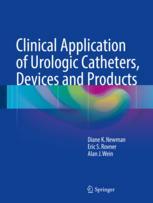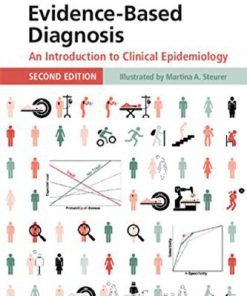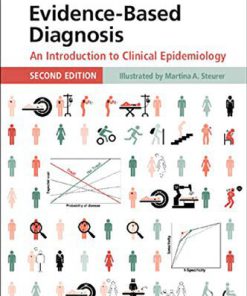Clinical Application of Urologic Catheters Devices and Products 1st Edition by Diane Newman, Eric Rovner, Alan Wein ISBN 9783319148212 3319148214
$50.00 Original price was: $50.00.$25.00Current price is: $25.00.
Clinical Application of Urologic Catheters Devices and Products 1st Edition by Diane Newman, Eric Rovner, Alan Wein – Ebook PDF Instant Download/Delivery: 9783319148212 ,3319148214
Full download Clinical Application of Urologic Catheters Devices and Products 1st Edition after payment

Product details:
ISBN 10: 3319148214
ISBN 13: 9783319148212
Author: Diane Newman, Eric Rovner, Alan Wein
Clinical Application of Urologic Catheters Devices and Products 1st Edition Table of contents:
- History
- Catheterization Descriptions
- Urinary Retention
- Prevalence
- Indications
- Characteristics of Urinary Catheters
- Types
- Materials
- Designs
- Balloon Specifics
- Catheter Tips and Eyelets
- Catheterization Techniques/Procedure
- Positioning for Catheterization
- Transurethral
- Suprapubic (SP) Catheterization Tubes
- Catheter Changing Schedule
- Lubrication
- Catheter Securement
- Catheter-Related Complications
- Increased Mortality and Morbidity
- Infectious Complications
- Bacteriuria
- Catheter Biofilms
- Catheter-Associated Urinary Tract Infections (CAUTIs)
- Catheter Blockage Secondary to Encrustations from Biofilm Formations
- Non-Infectious Complications
- Leakage Around the Catheter
- Catheter Expulsion or Inadvertent Dislodgment
- Urethra Complications
- Bladder Stones
- Squamous Cell Cancer
- Hematuria
- Catheter-Related Pain
- Skin Breakdown
- Prevention of Catheter-Related Complications
- Evidence-Based Indwelling Urinary Catheter Research
- Best Practices for Management
- Management of Long-Term IUCs
- Patient Information
- Appendix 1: Guide to Catheterization
- Care and Use of an Indwelling Urinary Catheter Patient Education Tool
- What Is an Indwelling Urinary Catheter?
- Why Do I Need an Indwelling Catheter?
- How Does a Catheter Feel?
- How to Care for Your Catheter?
- How to Position Your Catheter and Drainage Bag
- Securing the Catheter
- How to Prevent Infections
- Can I Have Sex with the Catheter in My Bladder?
- What to Do and What Not to Do
- Call Your Doctor or Nurse if:
- References
- 2: Catheters Used for Intermittent Catheterization
- Definition
- Indications: (Urinary Retention and NLUTD)
- Methods
- History of Intermittent Catheterization
- Advantages of Intermittent Catheterization
- Characteristics of Intermittent Catheters
- Catheter Reuse
- Closed vs. Open System Catheters
- Materials
- Designs
- Evidence-Base Research
- Special Features and Devices for IC
- Urine Collection Devices/Urinals for Use With Intermittent Catheterization
- Promoting Patient Adherence To Intermittent Self-Catheterization
- Complications
- Risk Factors for Development of UTI in Persons on IC
- Prevention of Catheter-Associated UTI (CAUTI)
- Management Strategies for Infection Prevention
- Techniques/Procedures for Intermittent Catheterization
- Patient-Related Questionnaires
- Educating the Patient about Intermittent Catheterization
- Patient Information
- Intermittent-Catheterization for Men Patient Education Tool
- What Is Intermittent Catheterization?
- Why Do I Have to Catheterize?
- What Can Happen if I Do Not Catheterize?
- What Is the Procedure I Should Follow?
- How Often Do You Have To Catheterize
- Taking Care of Your Catheter
- Helpful Tips
- What Problems Might Occur?
- The Following Catheter Has Been Prescribed for You
- Intermittent-Catheterization for Women Patient Education Tool
- What Is Catheterization?
- Why Do I Have to Catheterize?
- What Can Happen if I Do Not Catheterize?
- What Is the Procedure I Should Follow?
- How Often Do You Have to Catheterize?
- Taking Care of Your Catheter
- Helpful Tips
- What Problems Might Occur?
- The Following Catheter Has Been Prescribed for You
- References
- 3: External Catheter Collection Systems
- Definition
- Indications
- Prevalence
- Description of Disposable Male External Catheters
- Material
- Types
- Descriptions of Disposable External Pouches
- Material
- Types
- Designs
- Description of External Catheter Containment Systems
- Types
- Considerations for Use of MECs
- Application of MECs
- Adverse Events
- Evidence-Based Research
- Patient Information
- How to Use a Male External Catheter Patient Education Tool
- What Is an External Catheter?
- Types of External Catheters
- Putting on a Disposable External Catheter
- Solving Problems with Your External Catheter
- References
- 4: Ureteral Stents, Nephrostomy Tubes, and Urethral Dilators
- Overview
- Ureteral Stent
- Definition
- Indications
- Materials
- Techniques for Use
- Complications/Adverse Events/Prevention
- Best Practice Management for Adverse Events
- Stent Encrustation and the Forgotten Stent
- Stent Failure
- Stent Migration
- Percutaneous Nephrostomy Tube
- Definition
- Indications
- Materials
- Designs
- Complications
- Prevention of Nephrostomy-Related Adverse Events
- Evidence Based Practice Management for Stents and Nephrostomy Tubes
- Stent After Ureteroscopy
- Ureteral Stent Versus Percutaneous Nephrostomy Tubes for Hydronephrosis and Obstruction
- Pregnancy
- Best Practice Management
- Urethral Stents and Dilators
- Urethral Stents
- Urethral Dilators
- Meatal Dilators
- Complications of Urethral Dilators
- Patient Information
- Ureteral Stent Patient Education Tool
- What Is a Ureteral Stent?
- How Is a Ureteral Stent Placed?
- How Long Does the Ureteral Stent Stay In?
- How Is a Stent Removed?
- Are There Alternatives to a Stent?
- Are There Side Effects of Having a Ureteral Stent?
- Are There Any Restrictions with the Stent?
- Helpful Tips
- When Should I Call for Help?
- Care of a Nephrostomy Tube Patient Education Tool
- What Is a Nephrostomy Tube?
- How to Care for a Nephrostomy Tube?
- How to Change a Nephrostomy Tube Dressing
- When to Follow-Up?
- Helpful Tips
- When to Call the Doctor?
- Performing Meatal Dilation Patient Education Tool
- What Is a Meatal Stenosis?
- What Causes This?
- How Do I Know If I Have This Problem?
- What Is the Treatment?
- What Equipment Do I Need?
- How Do I Dilate?
- When Do I Call the Doctor?
- Remember
- References
- 5: Urinary Drainage Bags
- Overview
- Definition
- Indications
- Types
- Materials
- Designs
- Techniques/Procedure for Use
- Problems
- Complications
- Adverse Events
- Prevention
- Evidence-Base Evidence
- Best Practices for Management
- Clinical Publications
- Research
- Patient Information
- Teaching Tools
- Education
- Conclusion
- Patient Information
- Urinary Drainage Bag Care Patient Education Tool
- What Is a Urinary Drainage Bag?
- Emptying Your Drainage Bag
- How to Position Your Drainage Bag
- How to Disconnect or Change Your Drainage Bag
- How to Clean Your Drainage Bag
- What If I Get an Infection?
- References
- 6: Absorbent Products for Incontinence
- Overview
- Indications
- Prevalence
- Product Types and Categories
- Technological Advances in Absorbency
- Product Functional Design and Application
- Underpads
- Potential Complications
- Adverse Events
- Selecting the Appropriate Product and Best Practices for Use
- Best Practices for Use
- Changing Products
- Preventing Skin Breakdown
- Evidence-Based Research
- References
- 7: Urologic Devices
- Introduction
- Urostomy Pouch
- Definition
- Indications
- Materials
- Designs
- Techniques/Procedure for Use
- Emptying the Pouch
- Pouch Drainage
- Problems/Complications/Adverse Events
- Patient Information
- Teaching Tools
- Penile Compression Devices
- Definition
- Indications
- Materials
- Designs
- Technique/Procedure for Use
- Cleaning Instructions
- Problems/Complications/Adverse Events
- Evidence Base for Clinical Use
- Patient Information
- General
- Product Care
- How to Use A Penis Clamp Patient Education Tool
- What Is a Penis Clamp?
- What Does a Clamp Look Like?
- How Do I Put on a Clamp?
- External Urethral Device
- Definition
- Indications
- Material
- Techniques/Procedure for Use
- Problems/Complications/Adverse Events
- Evidence Base for Clinical Use
- Putting on the Finess™ Barrier Device Patient Education Tool
- Intraurethral Inserts
- Definition
- inFlow™ Control Device
- Definition
- Indications
- Description
- Materials
- Technique/Procedure
- Problems/Complications/Adverse Events
- Evidence Base for Clinical Use
- Intravaginal Devices
- Pessary
- Definition
- Pessary for Pelvic Organ Prolapse
- Indications
- Pessary for Incontinence
- Additional Uses of a Pessary
- Surgical Scheduling or Avoidance
- Surgical Planning: Diagnosis and Prediction of Surgical Outcome
- Prevention of Worsening POP
- Pregnancy Complications
- Materials
- Designs
- Techniques/Procedure for Use
- Follow-Up Pessary Care
- Removal and Cleaning Regimen
- Other Considerations
- Estrogen Transvaginal Therapy
- Pelvic Floor Muscle Training
- Sexual Activity
- Menstruation
- Continued Pessary Use
- Causes for Pessary Discontinuation
- Contraindications/Problems
- Contraindications
- Problems
- Complications/Adverse Events
- Evidence Base for Clinical Use
- Patient Information
- Teaching Tools and Education
- Other Vaginal Support Devices
- Definition
- Indications
- Materials/Designs
- Techniques/Procedure for Use
- Problems/Complications
- Evidence-Base for Clinical Use
- Toileting Assistive Devices
- Definition
- Toilets
- Other Toileting and Personal Hygiene Aids
- Evidence-Base for Clinical Use
- Patient Information
- References
- 8: Perineal Skin Care Considerations
- Overview
- Properties and Function of Skin
- Definitions
- Etiology of Incontinence Associated Dermatitis
- Prevalence
- Assessment
- Evidence-Based Research for IAD Prevention
- Cleansers
- Skin Protectants/Barrier
- Moisturizers
- Prevention
- Management – Skin Care Program
- Patient and Caregiver Education
- References
- Index
People also search for Clinical Application of Urologic Catheters Devices and Products 1st Edition:
clinical application of urologic catheters devices and products
importance of urinary catheterization
catheter after urolift procedure
catheter-associated urinary tract infection in adults
Tags:
Diane Newman,Eric Rovner,Alan Wein,Clinical Application,Urologic Catheters,Devices,Products
You may also like…
Cookbooks
Medicine - Neuroscience
Neuroprotective Natural Products Clinical Aspects and Mode of Action 1st Edition Goutam Brahmachari
Medicine - Epidemiology
Evidence Based Diagnosis An Introduction to Clinical Epidemiology Thomas B. Newman
Medicine
Evidence Based Diagnosis An Introduction to Clinical Epidemiology 2nd Edition Thomas B. Newman
Engineering
Fundamentals of Electroceramics Materials Devices and Applications 1st Edition R. K. Pandey
Engineering Technique - Energy












